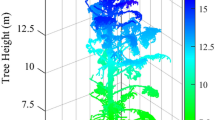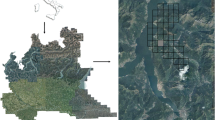Abstract
In order to determine current tree condition and predict future growth using LiDAR data, tree height, diameter at breast height, diameter 4 m above the ground, tree volume, tree volume growth, diameter at breast height growth and diameter growth 4 m above ground for individual trees were estimated from various crown height metrics and measurements obtained using a small footprint airborne laser scanner flown over a planted forest in Japan. Ground-truth values for tree height, diameter at breast height, diameter 4 m above ground, tree volume, and volume and diameter growth were collected. The actual values were compared with the laser-derived crown height metrics, including: percentiles, maximum, mean, coefficient of variation and crown density, all for the first and last crown height laser pulses. The regressions explained 75–79 % of the variability in ground-truth tree height, diameter at breast height, diameter 4 m above ground and tree volume. Cross-validation of the regressions revealed standard deviations of the differences between predicted and ground-truth values of 1.30 m (6.7 %), 5.2 cm (22.2 %), 3.8 cm (18.7 %) and 0.22 m3 (43.3 % of ground-truth mean), respectively. The regressions also explained 69–77 % of the variability in ground-truth averages. Cross-validation of the regressions revealed standard deviations of the differences between predicted and ground-truth values of 0.15 cm yr−1 (43.7 %), 0.1 cm yr−1 (31.0 %) and 0.008 m3 yr−1 (58.5 % of ground-truth mean), respectively. The study confirms that it may be possible to predict individual tree growth based on LiDAR data.

Similar content being viewed by others
References
Andersen, H.-E., McGaughey, R. J., & Reutebuch, S. E. (2005). Estimating forest canopy fuel parameters using LIDAR data. Remote Sensing of Environment, 94, 441–449.
Arain, M. A., & Restrepo-Coupe, N. (2005). Net ecosystem production in a temperate pine plantation in southeastern Canada. Agricultural and Forest Meteorology, 128, 223–241.
Behera, M. D., & Roy, P. S. (2002). Lidar remote sensing for forestry applications. Current Science, 83, 1320–1328.
Coops, N. C., Hilker, T., Wulder, M. A., St-Onge, B., Newnham, G., Siggins, A., & Trofymow, J. A. (2007). Estimating canopy structure of Douglas-fir forest stands from discrete-return LiDAR. Trees-Structure and Function, 21, 295–310.
Dean, T. J., Cao, Q. V., Roberts, S. D., & Evans, D. L. (2009). Measuring heights to crown base and crown median with LiDAR in a mature, even-aged loblolly pine stand. Forest Ecology and Management, 257, 126–133.
Farid, A., Goodrich, D. C., & Sorooshian, S. (2006). Using lidar to discern age classes of cottonwood trees in a riparian area. Western Journal of Applied Forestry, 21, 149–158.
Forestry Agency. (1970). Volume table — eastern Japan. Tokyo: Japan Forestry Investigation Committee. 333 pp (in Japanese).
Hiroshima, T., & Nakajima, T. (2006). Estimation of sequestered carbon in Article-3.4 private planted forests in the first commitment period in Japan. Journal of Japanese Forest Research, 11, 427–437.
Holmgren, J. (2004). Prediction of tree height, basal area and stem volume in forest stands using airborne laser scanning. Scandinavian Journal of Forest Research, 19, 543–553.
Labrecque, S., Fournier, R. A., Luther, J. E., & Piercey, D. (2006). A comparison of four methods to map biomass from Landsat-TM and inventory data in western Newfoundland. Forest Ecology and Management, 226, 129–144.
Lefsky, M. A., Harding, D., Cohen, W. B., Parker, G., & Shugart, H. H. (1999). Surface lidar remote sensing of basal area and biomass in deciduous forests of eastern Maryland, USA. Remote Sensing of Environment, 67, 83–98.
Magnussen, S., Eggermont, P., & LaRiccia, V. N. (1999). Recovering tree heights from airborne laser scanner data. Forest Science, 45, 407–422.
Means, J. E., Acker, S. A., Harding, D. J., Blair, J. B., Lefsky, M. A., Cohen, W. B., Harmon, M. E., & McKee, W. A. (1999). Use of large-footprint scanning airborne lidar to estimate forest stand characteristics in the western cascades of Oregon. Remote Sensing of Environment, 67, 298–308.
Means, J. E., Acker, S. A., Brandon, J. F., Renslow, M., Emerson, L., & Hendrix, C. J. (2000). Predicting forest stand characteristics with airborne scanning lidar. Photogrammetric Engineering and Remote Sensing, 66, 1367–1371.
MicroImages, Inc. (2001). TNTmips ver. 6.6. Lincoln, NE, USA.
Naesset, E., & Okland, T. (2002). Estimating tree height and tree crown properties using airborne scanning laser in a boreal nature reserve. Remote Sensing of Environment, 79, 105–115.
Nagumo, H, Minowa, M. (1990). Forest measurement (in Japanese), Chikyusya, Tokyo.
Nakajima, T., Hirata, Y., Hiroshima, T., Furuya, N., Tatsuhara, S., Tsuyuki, S., & Shiraishi, N. (2011). A growth prediction system for local stand volume derived from LIDAR data. GIScience and Remote Sensing, 48, 394–415.
Nelson, R. (1997). Modelling forest canopy heights: the effects of canopy shape. Remote Sensing of Environment, 60, 327–334.
Nelson, R., Krabill, W., & Tonelli, J. (1988). Estimating forest biomass and volume using airborne laser data. Remote Sensing of Environment, 24, 247–267.
Nelson, R., Oderwald, R., & Gregoire, G. (1997). Separating the ground and airborne laser sampling phases to estimate tropical forest basal area, volume, and biomass. Remote Sensing of Environment, 60, 311–326.
Nelson, R., Valenti, M. A., Short, A., & Keller, C. (2003). A multiple resource inventory of Delaware using airborne laser data. BioScience, 53, 981–992.
Nelson, R., Short, A., & Valenti, M. (2004). Measuring biomass and carbon in Delaware using an airborne profiling lidar. Scandinavian Journal of Forest Research, 19, 500–511.
Nilsson, M. (1996). Estimation of tree heights and stand volume using an airborne lidar system. Remote Sensing of Environment, 56, 1–7.
Persson, A., Holmgren, J., & Söderman, U. (2002). Detecting and measuring individual trees using an airborne laser scanner. Photogrammetric Engineering and Remote Sensing, 68, 925–932.
Popescu, S. C., Wynne, R. H., & Nelson, R. F. (2003). Measuring individual tree crown diameter with lidar and assessing its influence on estimating forest volume and biomass. Canadian Journal of Remote Sensing, 29, 564–577.
Roberts, S. D., Dean, T. J., Evans, D. L., McCombs, J. W., Harrington, R. L., & Glass, P. A. (2005). Estimating individual tree leaf area in loblolly pine plantations using LiDAR-derived measurements of height and crown dimensions. Forest Ecology and Management, 213(22), 54–70.
Social Survey Research Information Co., Ltd., (2006). Excel statistics 2006. Tokyo, Japan.
Weisberg, S. (1985). Applied linear regression (2nd ed.). New York: Wiley. 324 pp.
Yu, X., Hyyppä, J., Kaartinen, H., & Maltamo, M. (2004). Automatic detection of harvested trees and determination of forest growth using airborne laser scanning. Remote Sensing of Environment, 90, 451–462.
Acknowledgments
We thank the staff of the University Forest in Chiba, University of Tokyo, for their assistance with field measurements. This study was partly supported by the Japan Society for the Promotion of Science.
Author information
Authors and Affiliations
Corresponding author
About this article
Cite this article
Nakajima, T. Estimating Tree Growth Using Crown Metrics Derived from LiDAR Data. J Indian Soc Remote Sens 44, 217–223 (2016). https://doi.org/10.1007/s12524-015-0494-9
Received:
Accepted:
Published:
Issue Date:
DOI: https://doi.org/10.1007/s12524-015-0494-9




